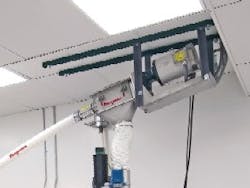Photo 1. In the Macleod plant, the screw conveyor transfers powder from the blender into a discharge adaptor above a filling machine. The conveyor can also be rerouted and attached to a mixer for drugs being made into paste form. Courtesy of Flexicon.
|
Dust control was paramount. The companys antibiotics are typically comprised of seven or eight powdered ingredients that are dumped manually from fiber drums into a 25-cubic-foot ribbon blender. Macleod enlisted the help of Poudre Valley Air of Fort Collins to design a motor-driven extractor system that draws off dust during dumping and transfers it to filters. The filters are then removed and cleaned in bag-in, bag-out fashion after each manufacturing campaign.Ceiling dust collectors with HEPA filters also serve to maintain air quality. While solid-dosage veterinary products do not require a sterile environment in GMP terms, it doesnt mean you want bacteria in the product you make, says Parrinello. Minimizing pollution is critical to worker safety, and to ensuring that products do not contaminate each other from batch to batch. Following blending, materials are gravity-discharged from the belly of the equipment, then conveyed to either a mixer, if a paste is to be made, or filling equipment if the drug is to remain in powder form.Macleod needed to find a conveying system that would be suitable for an extremely small manufacturing areaabout 20 by 30 feet, says Parrinello, with a 10-by-15-foot space for the blender and conveying system. In most cases, a conveyor attached to the blender would transfer product vertically, then drop it into another mixer or filling machine. With just a 10-foot ceiling, Macleod didnt have that luxury.The company weighed different conveying products that offered optimal dust control. It considered vacuum conveyers, but decided to go with the simplicity and lower cost that screw conveyors offered, says Parrinello. After evaluating several models, it selected a screw conveyer by Flexicon (Bethlehem, Pa.).The Flexicon conveyor features a flexible, motor-driven screw within three-inch plastic tubing. The screw is the conveyors only moving part that comes in contact with blended material, and removes easily for simplified cleaning during product changeover. It is one reason that Macleods validated cleaning process takes roughly half a day, says Parrinello. Flexicon also offered air-tight adaptors at both ends of the conveyor, to eliminate the possibility of dust escaping during material transfer. The companys engineers designed a special flange that attached to the blenders valve to allow material to be discharged directly into the adaptor, with no outside exposure.Dangerous curve aheadNow came the hard part. In other installations, Flexicon typically angles its conveyers at 45 degrees out of the charging adaptor. Because of the height limitations at Macleod, it decided to start at 45 degrees, then bend the tube downward to attach to the discharge adaptor (Photo 1, above).







